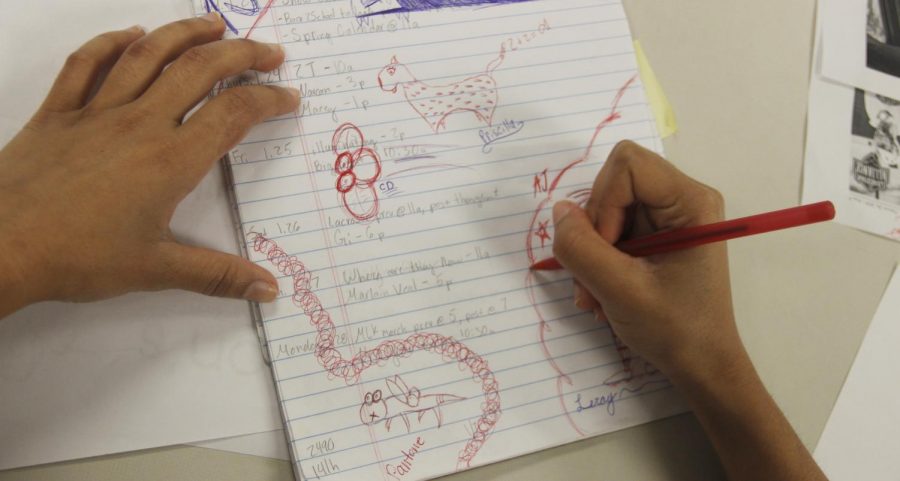Learn in the margin
Zachary Araki/The Lion’s Roar
While studying or taking notes, some students doodle to increase their academic performance. The activity provides a baseline level to keep students engaged during class.
To improve academic performance, stay awake in yet another class, or pass the time, students incorporate doodles with their notes.
Maintaining a baseline level of activity can help to engage the brain. For this reason, some teachers try to incorporate classroom discussions or hands-on learning activities, but falling short of that, students may need to find their own studying tools.
“If a student can doodle during that time, it gives them that baseline level of activity so they are engaged in some way, but they are free to listen assuming they have basic focusing skills,” said Dr. Sara Sohr-Preston, assistant professor of psychology. “Some students may have difficulty multitasking, but a lot of students will say that they use doodling as a focusing activity. It’s not a distraction even though it could potentially be something you’re doing instead of listening to the lecture.”
In a 2009 study, Jackie Andrade, professor of psychology at the University of Plymouth, tested how doodling affected attention. In the study, 40 participants monitored a telephone message. Half of them doodled while listening to the message, and that group recalled 29 percent more information on a memory test compared to the group that did not doodle.
According to Sohr-Preston, the benefit of doodling with respect to attention can resemble the benefit of fidget spinners.
Despite the potential benefits of doodling, some people may perceive the activity as no more than a distraction.
Sohr-Preston stated, “Some people like to shame students who they see doodling in class like, ‘Oh, you’re not even paying attention. You’re doodling,’ and I’m one of those people, I’m like, ‘No, never assume that because they may be doing that so they can pay attention, so they can focus.’ If they weren’t allowed to doodle, they might start wandering off or fidgeting or wanting to text on their phone because that gives them something to do too.”
Based on the 1938 article “Spontaneous Drawings as an Approach to some Problems of Psychopathology,” doodling may relieve motor tension and psychological distress.” The authors said that doodles “are produced in idleness, boredom, leisure, meditation, or in states showing affective tension, such as indecision, concentration, expectation, and impatience.”
Though doodling may serve as another distraction to drown out class content, its effectiveness depends on the student.
Sohr-Preston explained, “Some students definitely will use doodling as a distraction like they’re bored with the lecture, so they’ll doodle so they can look at anything else, but there are more engaged students, or more planful students, who know they can’t just sit there and listen. They know their minds are gonna wander if they just sit there and do nothing, so they keep themselves active by doodling.”
Daisy Frey, a junior biological sciences major, doodles in her classes depending on the subject material, and at times, the activity benefits her learning experience.
“When you’re doodling, when you look back at it, I can connect stuff sometimes,” shared Frey. “I don’t think it always helps. It probably doesn’t help all the time, but at least remembering stuff in general.”
For Sohr-Preston, doodling helps with focus outside of the classroom.
Sohr-Preston said, “I doodle during faculty meetings because I know sometimes that if I don’t, I’m gonna look out the window and think of other things, and I know I need to be focusing on what’s being said.”
Your donation will support The Lion's Roar student journalists at Southeastern Louisiana University.
In addition, your contribution will allow us to cover our annual website hosting costs.
No gift is too small.






